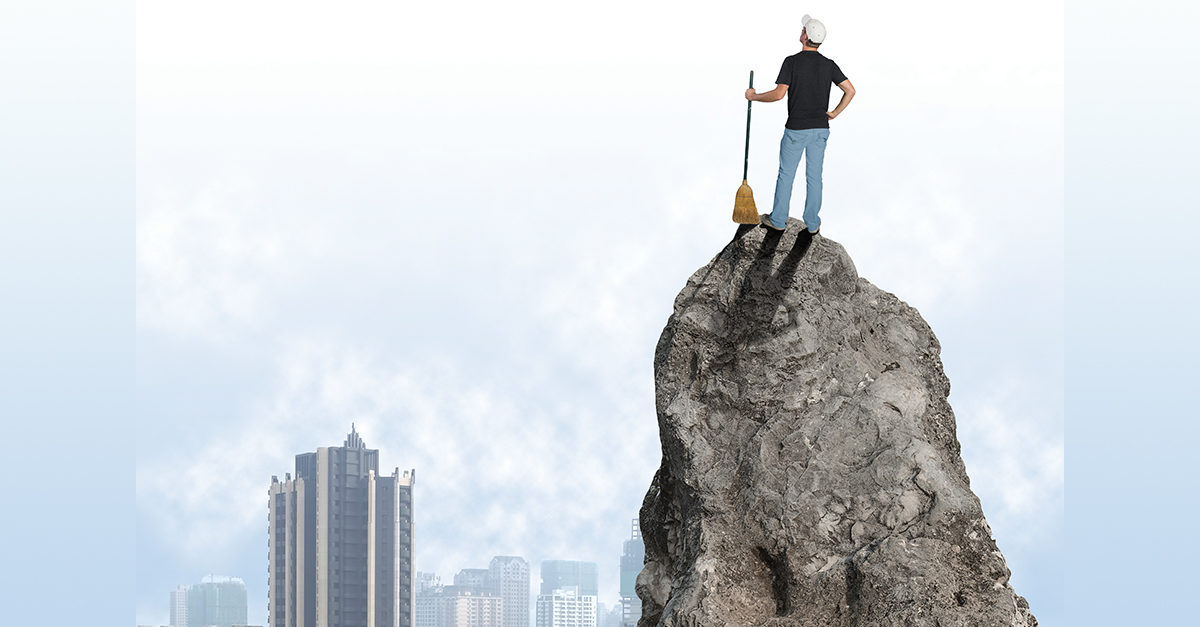Cleaning is vital to public health, yet the role of the janitor (or custodian) is often perceived negatively—and not only by building occupants, but also by janitors themselves.
However, for janitors, there’s a lot more at stake than negative stereotypes.
Janitorial workers experience one of the highest rates of occupational asthma, twice the rate than other workers, according to a 2001 article published by the American Journal of Industrial Medicine. There’s also a host of other dangers that could come from mixing the wrong chemicals, the increased likelihood of slip-and-fall injuries, not to mention the potential impact on public health if the job is not done right.
Despite all of these risks, janitors play a huge role in protecting the health of building occupants. They prevent the spread of illness and infection, control indoor air quality, and protect the indoor environment. Then why the bad reputation?
Unlike many European countries, there are no education requirements or necessary certifications for janitors in the United States. There’s also the problem of low pay; the U.S. Bureau of Labor Statistics found a median pay for janitors and building cleaners to be just more than US$22,000 per year and $10.73 per hour.
“It’s all theory about why the industry has not advanced in the United States,” says John Lawter, associate director of plant operations for the University of Michigan’s Plant Building and Ground Services Division. “But the prevailing thought is that most people want to keep the wage rates low. Once you start attaching certifications to any profession, it raises the amount you have to pay people. These people work hard, they do a dirty and repetitive job, they work late at night, and there’s lots of things that can go wrong. They deserve to be paid fairly for what they do.”
Training Means Retention
Turnover is a constant problem in custodial services, with rates cited anywhere between 50 and 400 percent by various building service contractors. That means facilities could be replacing their entire workforce between once every two years and four times per year.
Training programs are an underutilized way to help tackle this problem. Not only does regular, in-depth training provide the opportunity to raise pay, but it also shows workers that the organization cares about them, enhances skills and job performance, and helps with turnover.
Bill McGarvey, director of training and sustainability for the Philip Rosenau Co., a distributor of janitorial and sanitary maintenance products, has seen training programs that led to higher pay also lead to better retention. One of his clients updated its contracts so that cleaning staff would make more money as they advanced through the course curriculum. After five years, “most of the folks are still there,” he says. “They don’t use training to weed people out, but people weeded themselves out.”
The budget often has the final say in training decisions. Many organizations don’t see the value in training when they look at it on paper. They see an upfront cost, the potential of having to pay more for certified and trained workers, and the loss of man hours that are spent training as negative impacts on the bottom line. “Some organizations don’t want to train people because they’re afraid they’ll go somewhere else, but on the flip side, what happens if you don’t train them and they stay?” McGarvey asks.
Promoting Higher Worker Value
Lawter’s approach to training at the University of Michigan is built on the OS1 management system, a training-based cleaning industry management model available through cleaning-industry consulting company Managemen.
“In our training classrooms, we use white linen tablecloths,” Lawter says, proudly. The way he sees it, this small detail lets his cleaning staff know their work is important, they are professionals, and they deserve to be taught in a pleasant environment. They also provide refreshments and have created a visually-instructive workplace in their training room.
Professional organizations, such as ISSA, the worldwide cleaning industry association, have training programs available specifically for frontline cleaning professionals. For example, ISSA’s Cleaning Industry Training Standard (CITS) offers the opportunity for frontline cleaners to receive training in specialty categories after passing a Cleaning 101 exam. Additionally, the Cleaning Management Institute (CMI) offers basic and advanced Custodial Technician Training and Certification programs, covering tasks such as carpet care, hard floor care, and restroom care.
Organizations don’t have to buy into a comprehensive management system to find in-depth, high-quality training programs for their workforce. In fact, most suppliers offer complimentary training for cleaning staff as a courtesy for doing business with them.
Daniel Josephs, chief operating officer and executive vice president of JanSan distribution company Spruce Industries says, “Any facility manager has the ability to go to their supplier and ask for hands-on product and procedure training.” However, he adds, this raises a question about “the caliber of training they are going to receive.” Joseph recommends finding a training program that moves beyond how to hold a mop and dives into the chemistry behind cleaning.
One way to identify a high-quality training program is to ask how often the staff should be trained. “For me, that’s a good question to define what the supplier really thinks training is,” Josephs says. “It’s like going to the gym. If you go once or twice a year it’s not going to make a difference. Training is the same way. If it’s repetitive and constant you’re definitely going to get more buy-in from the staff.”
The Impact of Recognition and Praise
There’s a famous story about John F. Kennedy’s encounter with a janitor who was cleaning a bathroom at NASA. Kennedy asked the man what he was doing, to which the custodian replied, “Mr. President, I’m helping to put a man on the moon.” That’s the kind of pride that exemplifies the true role of a janitor’s work. By telling inspiring stories of cleaning staff taking a proactive, engaged, and proud stake in their role, the cleaning industry can help push the janitorial narrative forward—and move beyond negative perceptions.
One study, conducted by Amy Wrzesniewski and Jane E. Dutton of Yale School of Management, proved that cleaners had the capacity to improve the meaning and identity of their work by being proactive, engaging with others, and seeing their value in the larger context of the organization.
Wrzesniewski and Dutton interviewed 28 members of a hospital cleaning staff and found that the cleaners fell into two groups: One group didn’t like cleaning, and didn’t value their skills or role as a cleaner. The second, happier group took great pride in their work. The study noted the happier cleaners understood the value of their work and altered the relational nature of their job to form bonds with patients, colleagues, and other building occupants. These cleaners enjoyed cleaning and felt the work was highly skilled. They engaged in tasks that made the jobs and lives of patients, visitors, nurses, and clerks easier.
Another key observation of the happier, more proactive cleaners was their ability to see their work within a larger context. These cleaners were able to look at how their tasks fit into a cohesive whole. Rather than focus on one highly specific task, the happier cleaners could see beyond it and how it impacted the greater good with a cleaner hospital, infection control, and patient satisfaction.
How can managers and organizations promote this proactive, heightened sense of value in their cleaning staff? Training helps. But praise and recognition go a long way, too.
Facility managers and supervisors can make a huge impact free of charge by reminding staff of the importance of what they do. When it comes to cleaning, people usually don’t notice the job until something isn’t done right, or when there’s an outbreak of an infection or illness. Taking the time to notice when the job’s being done well will pay huge dividends in lifting employee morale and keeping folks around longer.
Josephs recalls a program his company recently completed with staff members at a local community college. “Even with something as simple as giving them a certificate and a pat on the back, and telling them that absenteeism was down because of what they [were] doing had just a humongous impact on their work,” he said. “The department saw less lateness, less sleeping on the job, and an overall upgrade in their work.”
McGarvey understands the value of a pat on the back, too. “When I am talking to a group of custodial folks, I actually see them sit up a little straighter when I tell them nobody has a more direct effect on the health of the building occupants than them.” It’s a message that doesn’t get said enough.
Add Recognition to Your Cleaning Program
One of the easiest ways to enhance your training program is to add recognition for those who complete the work. Recognition helps to boost employee morale, show that you value your workers, and creates a sense of pride, as well as friendly competition among staff. Here are some simple ideas for recognizing your staff members:
- Award a certificate to all workers upon completion of a training program. Host an awards ceremony where the rest of the department, managers, and others (such as board members or administrators in a school environment) attend.
- Create an employee of the month program, where other members of the staff can nominate or vote on the recipient. Make sure to recognize the employee within your group as well as within the larger building community.
- Apply for outside awards. The government, nonprofits, and trade associations offer a host of awards programs designed to recognize and publicize hard-working cleaning staff. Don’t forget to publicize your participation.




